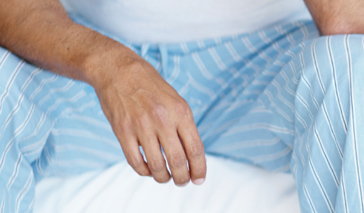Orchitis refers to the inflammation of one or both testicles, and can be caused by either a viral or bacterial infection. Symptoms can include fatigue, nausea, and fever, and can lead to complications. Orchitis can occur alone (isolated) or concurrent with epididymitis, an inflammation of the epididymis (the coiled tube at the back of the testicle that stores sperm).
Causes of Orchitis
Viral Infection
Isolated orchitis is most often caused by the mumps virus, and four-fifths of these cases occur in boys under 10 years old. Orchitis symptoms usually appear four to seven days after the start of the initial infection.
Seventy percent of mumps orchitis cases begin in just one affected testicle, but the second is often affected within 1 to 9 days.
Rarely, viral orchitis can be caused by other viruses, such as varicella, echovirus, infectious mononucleosis, or coxsackievirus.
Bacterial Infection
Bacterial orchitis most commonly co-occurs with epididymal inflammation (epididymo-orchitis), and happens when the infection spreads from epididymis to testicle. And unlike viral orchitis, 90 percent of bacterial orchitis cases involve only one testicle.
Causes of bacterial orchitis include:
- Sexually-transmitted infections, such as chlamydia or gonorrhea
- Benign prostatic hyperplasia (enlarged prostate blocks urine flow, causing the fluid to remain in the urinary system and allowing bacteria to multiply)
- E. coli
- Urinary tract abnormalities that cause urine and bacteria reflux (flow backwards)into the epididymis
- Catheters, which introduce bacteria to the urinary system
- Surgery in the urinary tract or genitals
Symptoms of Orchitis
Symptoms of orchitis can include:
- Enlarged testicle, one or both
- Pain or tenderness in the testicle, ranging from mild to severe
- Discomfort while sitting
- Fatigue
- Nausea
- Fever and chills
- Headache
- Discharge from the penis
Orchitis Complications
Orchitis can also result in other problems, such as:
- Shrinkage of the affected testicle (atrophy), which occurs in 60 percent of cases
- Pus in the infected tissue (abscess)
- Repeated episodes of epididymitis
- Impaired fertility (7 to 13 percent of cases)
- Infertility (particularly when both testicles are affected)
How is Orchitis Diagnosed?
Physicians start with medical history and a physical exam (looking for enlarged lymph nodes in the groin, enlarged testicles, and/or enlarged prostate) to determine whether they think orchitis might be present. They may also use one ore more of the following to confirm diagnosis:
- STI screening
- Urine tests and cultures
- Color Doppler ultrasound imaging can reveal swelling and increased blood flow: Blood flow to the testicle increases during orchitis, while torsion of the testicle reduces blood flow.
How is Orchitis Treated?
The approach for orchitis treatment depends on which type you have. Viral orchitis is treated primarily by relieving the symptoms with pain medications, bed rest, elevation of the scrotum, or hot or cold packs. Bacterial orchitis requires treatment with antibiotics.
References
Gazibera B, Gojak R, Drnda A, et al. (2012). Spermiogram part of population with the manifest orchitis during an ongoing epidemic of mumps. Med Arh.
Trojian T. et al. (2009). Epididymitis and orchitis: An overview. Am Fam Phys.
Dogra V, Bhatt S. (2004). Acute painful scrotum. Radiol Clin North Am.
Kaver I, Matzkin H, Braf ZF. (1990). Epididymoorchitis: a retrospective study of 121 patients. J Fam Pract.
Raveenthiran V, Sam CJ. (2011). Epididymo-orchitis complicating anorectal malformations: collective review of 41 cases. J Urol. 186(4):1467-72.


